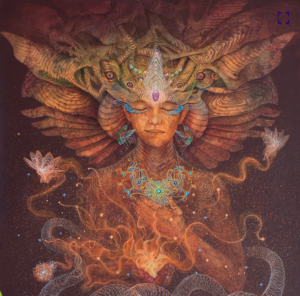Ayurveda and yoga, two sisters, offer something much deeper than just a medical approach to health.
When we think or talk about health, the question of the body and its infirmities usually comes to the fore. However, health (including physical health) is not only a question of the state of the physical body, due to the fact that human beings and their functioning go far beyond the structures of physicality and what is tangible.
Ayurveda and yoga, the two sisters, offer something much deeper than just a medical approach to health. They are holistic philosophies that place the parts of life that are subjective and unmeasurable on a par with objective and material reality. They understand that The intangible components of life: consciousness, mind, emotions and thoughts animate and direct what is material, measurable and tangible.
Ayu, or life
On this basis, Ayurveda defines Ayu , or life, as the intelligent and total interaction of four aspects:
- ATMA – soul
- MANAS – brain
- INDRIYA – senses
- SHARIRA – body
Each of these aspects has a specific function that contributes to the wholeness we experience as life. According to Ayurveda, imbalance (whether physical, emotional or mental) occurs when there is a disconnect between the non-physical and physical areas of life.
And when does this disconnect occur?
Most often, in the course of life, we encounter events that we subjectively interpret as traumatic, even when we are not aware of it at a conscious level. These traumas trigger internal conflicts within us (i.e. an internal struggle resulting from a sense of separation) that persists in the psyche, despite the fact that the source event has long since ended. This event, in addition to persisting in the realm of the psyche, is just as often retained in the body, due to the direct connection between body and mind.
Butterfly effect
The interesting thing about all this is that the perception of trauma is very individual: what one person perceives as traumatic, may not be so for another! It is all a matter of individual predisposition, which, in simple terms, is a mixture of information from DNA, temperament, personality predisposition and social conditioning. In practice, this means that siblings potentially experiencing the same situation from an early age perceive and process it very differently. We can conclude from this that even the smallest differences will have a huge impact on the further fate of each individual.
Are you interested in this article? Comment, ask questions, share with others ♥
POLSKI
Siostra Jogi – Ajurweda
Ajurweda i joga, dwie siostry, proponują coś znacznie głębszego, niż tylko medyczne podejście do zdrowia.
Kiedy myślimy lub rozmawiamy o zdrowiu, zazwyczaj na pierwszy plan wysuwa się kwestia ciała i jego niedomagań. Jednak zdrowie (również fizyczne) nie jest tylko kwestią stanu ciała fizycznego, z racji tego, że człowiek i jego funkcjonowanie wykracza znacznie poza struktury fizyczności i tego, co jest namacalne.
Ajurweda i joga, dwie siostry, proponują coś znacznie głębszego, niż tylko medyczne podejście do zdrowia. Są holistycznymi filozofiami, które na równi z obiektywną i materialną rzeczywistością stawiają części życia, które są subiektywne i niemierzalne. Rozumieją to, że niematerialne komponenty życia: świadomość, umysł, emocje i myśli ożywiają i kierują tym, co materialne, mierzalne i namacalne.
Ayu, czyli życie
Na tej podstawie ajurweda definiuje Ayu , czyli życie, jako inteligentną i totalną interakcję czterech aspektów:
- ATMA – dusza
- MANAS – umysł
- INDRIYA – zmysły
- SHARIRA – ciało
Każdy z tych aspektów pełni określoną funkcję, która przyczynia się do całości, której doświadczamy jako życie. Według ajurwedy brak równowagi (zarówno fizycznej, emocjonalnej, jak i mentalnej) następuje, gdy pojawia się rozłączenie pomiędzy niefizycznymi i fizycznymi obszarami życia.
A kiedy pojawia się to rozłączenie?
Najczęściej, w toku życia, spotykają nas wydarzenia, które subiektywnie odczytujemy jako traumatyczne, nawet, gdy nie zdajemy sobie z tego sprawy na poziomie świadomym. Te traumy wywołują w nas wewnętrzne konflikty (czyli walkę wewnętrzną będącą wynikiem poczucia rozdzielenia), które trwa w psychice, pomimo tego, że wydarzenie źródłowe już dawno się skończyło. To wydarzenie, oprócz tego, że trwa w sferze psyche, równie często zatrzymuje się w ciele, ze względu na bezpośredni związek ciała i umysłu.
Efekt motyla
Ciekawostką przy tym wszystkim jest to, że percepcja traumy jest bardzo indywidualna: to, co jedna osoba odczytuje jako traumatyczne, dla drugiej nie musi wcale takie być! Wszystko jest kwestią indywidualnych predyspozycji, czyli w dużym uproszczeniu, mieszanki informacji płynących z DNA, temperamentu, predyspozycji osobowościowych oraz warunkowania społecznego. W praktyce oznacza to, że rodzeństwo przeżywając potencjalnie tę samą sytuację już od wczesnego dzieciństwa postrzega i przetwarza ją zupełnie inaczej. Możemy z tego wnioskować, że nawet najdrobniejsze różnice będą miały ogromny wpływ na dalsze losy każdej z osób.
Zainteresował Cię artykuł? Komentuj, zadawaj pytania, dziel się z innymi ♥






One Response
Like!! Thank you for publishing this awesome article.